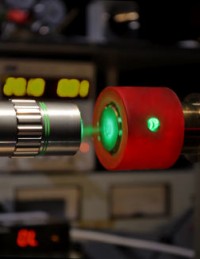
Experiments by researchers in the School's Centre for Science at Extreme Conditions (CSEC) have revealed anomalous behaviour in the melting temperatures of high-pressure dense hydrogen.
As reported in the prestigious "Nature Materials”, the study provides evidence that at above 200 GPa (2,000,000 atm) surprisingly low temperatures (480 K) are required to reach a liquid phase.
As the simplest, lightest and most abundant element of the Universe, hydrogen is of fundamental interest in many fields of physics. At high pressure and low temperatures, hydrogen is predicted to transform to a new type of ordered quantum fluid possessing both superconducting and superfluid properties. The high temperature behaviour is crucial to planetary science as hydrogen is believed to be found in the centre of Jovian planets and to be the source of their exceptionally high magnetic fields. Reaching such conditions in the experimental laboratory, long enough to comprehensively study the material, has been a great challenge in the field of high pressure research. Even high compression at room temperature was thought to be beyond experimental capabilities until recently.
Through new technological breakthroughs in the containment of hot hydrogen in diamond anvil cell experiments, Ross Howie, Philip Dalladay-Simpson and Eugene Gregoryanz at the Centre for Science at Extreme Conditions, provide evidence that after a maximum in the melting curve, the melting temperatures of hydrogen rapidly decrease with pressure, dropping to 480 K at 255 GPa. This consequently results in the lowest melting temperature for any material at such pressures.
Tracking this transformation over a large pressure regime through Raman spectroscopy, the team also discovered a triple point between hydrogen’s solid molecular Phase I, the recently discovered solid mixed molecular-atomic phase IV and the liquid phase.
Remarkably, at pressures above 260 GPa the melting line flattens out, raising many questions about the high pressure, high temperature behaviour of hydrogen at even higher densities. If the melting curve were to increase at higher densities then the phase diagram would markedly resemble what is observed in the rest of the group I elements in the periodic table. Such behaviour questions the existence of the exotic states that hydrogen has been theoretically predicted to possess and at the very least pushes the transition pressures much higher than previously thought.
“It is remarkable to think that 4 years ago, researchers were unable to compress hydrogen above 180 GPa and 200 K, and now we are probing the melt line, far surpassing these conditions. Although this study is a major breakthrough in hydrogen research, it poses more questions about its high pressure behaviour and may even cast doubt on the existence of predicted exotic phases. Nevertheless it is very exciting to think what may occur at higher densities and will no doubt stimulate further research.” Ross Howie, Centre for Science at Extreme Conditions
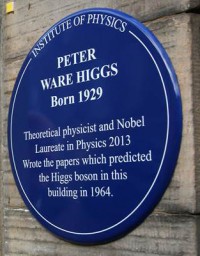
Professor Peter Higgs has unveiled a blue plaque in his honour at the University. The installation marks the site where Nobel Laureate Professor Higgs first devised his seminal theory on the nature of mass more than 50 years ago.
The theoretical physicist was a researcher at the University in 1964 when he predicted a sub-atomic particle, now known as the Higgs boson, which enables other particles to acquire mass. His idea was borne out by experiments almost 50 years later, in 2012, at the European Organization for Nuclear Research (CERN) in Switzerland. Professor Higgs was awarded a Nobel Prize for Physics in 2013 for his work.
It is truly historic to celebrate such a seminal theory in physics with its author, Peter Higgs, in the building where he first wrote it more than 50 years ago, and in the company of some of his colleagues from that time.
Prof. Richard Kenway, Vice Principal, University of Edinburgh
Commemoration
The plaque, at Roxburgh Street in Edinburgh, is sponsored by the Institute of Physics and Edinburgh City Council. It notes that Professor Higgs ‘Wrote the papers which predicted the Higgs boson in this building in 1964’.
Professor Higgs unveiled the plaque following a ceremony at the University at which he was awarded an honorary degree by the University of North Carolina at Chapel Hill. He spent a sabbatical year at the US University from 1965-1966. During this time he wrote an academic paper that would form the basis of experiments at CERN.
Degree tribute
His honorary Doctor of Science degree was conferred by the University of North Carolina’s Chancellor, Professor Carol L Folt, for ‘outstanding accomplishment in the field of theoretical physics, especially his fundamental work on the origin of mass’. The event was hosted by the University of Edinburgh’s Vice Principal Professor Richard Kenway and attended by students from UNC who are currently studying at Edinburgh.
Nearly half a century ago, Professor Higgs found himself at the University of North Carolina at Chapel Hill conducting revolutionary work in physics and his work continues to inspire us. His research had a profound impact on the field of fundamental physics, and his example motivates our faculty and students to pursue their passions and make their own significant mark on their discipline.
Prof. Carol L Folt, Chancellor, University of North Carolina at Chapel Hill
Image gallery

All University alumni are invited to become e-mentors for our 3rd, 4th and 5th-year undergraduates and all postgraduate students. The School's Judy Hardy explains how this innovative scheme works.
One of the best ways for students to gain an insight into what a particular job is really like is to talk to someone who is doing it. The choice of careers open to physics and astronomy graduates is vast. Career destinations reported by our recent alumni range from the scientific, technical, IT and financial sectors to the environmental industry, healthcare, teaching, retail, publishing and NGOs amongst others.
While some students have very clear career aims, others can be bewildered by the wide choice and find it difficult to know where to start, or may not even be aware of the full range of options open to them. Mentoring is an excellent way to help students explore and choose their career goals by talking to someone who is already doing a particular job.
Connect.ed
The Careers Service has recently launched an alumni e-mentoring scheme, Connect.ed, which links our alumni with current students or fellow alumni who are interested in a career in a similar area. By sharing experiences, offering suggestions or simply passing on information about their chosen field, e-mentors can help students to make informed career choices and to take their first steps towards achieving their aspirations.
There are also benefits for the e-mentor, with opportunities to consider and reflect on working practices, develop communication skills in a wider setting and build professional networks, as well as the personal satisfaction that comes from supporting others.
In outline, the scheme works as follows: e-mentors register their details, including a short career profile, via the secure MyEd Alumni Portal. Students can then browse the alumni profiles, again via MyEd, to identify and contact potential e-mentors. The e-mentor can then accept the relationship, which is conducted by email. The length of the relationship is flexible and can range from a simple one-off exchange of emails to a longer-term connection. The duration of the mentoring relationship, its scope and subject matter are agreed by e-mentor and e-mentee at the outset.
All University alumni are invited to become e-mentors. For e-mentees, the scheme is currently open to 3rd, 4th and 5th year undergraduates and all postgraduate students.
Why be an e-mentor?
- Share your experiences and insights into the realities of your job or career sector
- Help current students explore and decide on their career goals
- Reflect on your current role and working practice
- Enhance your interpersonal and communication skills
- Build links with other alumni, the School and the University.
Find out more about e-mentoring
To sign up as an e-mentor, or to find out more about the scheme, see the Connect.Ed website or Connected [at] ed.ac.uk (email the team). We are also happy to offer guidance and support for e-mentors.
The University Alumni Team
The Alumni Team provides opportunities for alumni to stay connected with the University and each other through events, reunions, clubs, networks and volunteering. It supports alumni by facilitating networking and professional development opportunities, and by providing a programme of benefits and services, including a range of publications. By highlighting and celebrating the achievements of our alumni, it aims to inspire the next generation of Edinburgh graduates.
Contact the Alumni Team
To find out more about how you can keep in touch or get involved, see the Alumni Services website or alumni [at] ed.ac.uk (email the team). You can also find them on:
This article also appeared in the School's newsletter, Enquire.
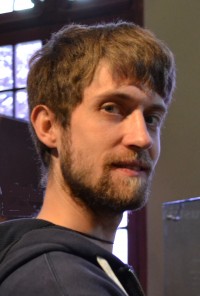
The Institute for Astronomy's Michal Michalowski has been awarded The Royal Astronomical Society's Winton Capital Award in astronomy.
Award citation
Dr Michałowski's main line of interest has been to study the origin of large dust masses in sub-millimetre galaxies, their evolution and their assembly into larger galaxies over time. This work has been documented in a remarkable output of well-cited publications. In another line of attack on the same problem of the evolution of the early universe, he has maintained his collaborative work on gamma ray bursts (GRBs) with researchers in Denmark, using GRBs to identify early galaxies and probe their properties. All this work has been carried out with numerous collaborators world-wide and a large range of cutting-edge observational facilities, spanning spectrum from the ultraviolet to the radio. It has been a dynamic start to a promising career.
Michal explains his work below.
I investigate the crucial component of the Universe, namely the cosmic dust residing in submm galaxies, gamma-ray bursts (GRB) host galaxies and quasars.
I found that submm galaxies contribute substantially (~20%) to the star-formation activity and the stellar mass density of the Universe, which justifies the need of understanding their nature. To reach this understanding I proved that they are not outlying galaxies in terms of star-formation properties. I also discovered that asymptotic giant branch (AGB) stars, or even supernovae are not efficient enough to form dust we see in these sources, hinting at grain growth in the interstellar medium as the main dust production mechanism. This is crucial in order to learn how dust formed in the early universe. I also tested the reliability of their stellar mass estimations - an important aspect of using them to constrain cosmological models. Finally, I found indications that GRBs trace cosmic star-formation, so they can be used as an excellent tool in cosmology.
I am honoured to receive this prestigious award! The list of previous award holders includes the best young astronomers in UK, so I am happy to be among them. This award gives me both the motivation for further research and shows the value and the recognition of my work, which is so important in the academic world. Michal Michalowski
Image gallery

Marina Cortes, a Marie Curie Research Fellow in the School's Institute for Astronomy, has been jointly awarded the 2014 Buchalter Cosmology Prize, along with Lee Smolin of the Perimeter Institute (Canada), for their paper “The Universe as a Process of Unique Events” (arXiv:1307.6167).
The judging committee recognised the work as “a remarkable approach for introducing the irreversible flow of time into the foundations of physics.”
This is the first year that the prize, which is worth 10,000 US dollars, has been awarded. It was announced at the American Astronomical Society meeting in Seattle on the 6th of January 2015.
"It's a great, great honour to receive this award. It is of course always an honour to see our work recognized, but this particular work is very special. The ideas in it are very different to those that are commonly accepted in the field, and it took courage and determination in voicing our own views. To see these ideas recognized by our most esteemed peers, and valued in this prize, is a reward beyond imagination. It gives us a strong impetus for continuing to develop them." Marina Cortes, Institute for Astronomy, Edinburgh
Below, Marina summarises her work, which is the result of a collaboration with Lee Smolin.
Time comes first: the arrow of time in cosmology and quantum gravity
We begin from the hypothesis that time is both fundamental and irreversible: a bold assertion, given that most physicists see time as a property that “emerges” as a consequence of more fundamental physical laws. Time results directly from this irreversibility; the future is created continuously out of the present through the activity of time. Every instant of time has a unique “fingerprint”—the signature sum of the instants that preceded it and no others.
These fundamentals results in a universe that is as asymmetric in time as possible. We develop our theory analytically, and show how space-time and partial quantum mechanics can arise from them. We then illustrate this through numerical simulations of a simplified model of a universe in which space has only a single dimension.
The new framework holds significant key implications for fundamental physics. Indeed, we argue that the primacy of time, and its irreversibility, must be incorporated into contemporary physics in order to make progress on key questions that beset the field. We believe that, ultimately, it may point the way to a unification of quantum mechanics with relativity –the “Holy Grail” of contemporary theoretical physics.
Image gallery
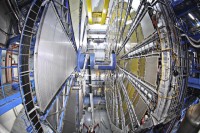
We are delighted to announce that the universities of Edinburgh and St Andrews have been rated as one of the top centres for Physics & Astronomy research in the UK.
PHYESTA, the joint School of Physics & Astronomy between the universities of Edinburgh and St Andrews, was ranked 4th out of 41 submissions in the REF-2014 listing as judged by the Research Fortnight Research Power index. This is particularly impressive as together we submitted over 100 staff for assessment and 96% of our research outputs were measured as 4*/3* (world-leading/internationally excellent). PHYESTA was thus placed fourth in the UK and first in Scotland.
Our performance on quality was even better; we were ranked third in the UK. This confirms the exceptional performance of our staff, our excellent facilities, and our world-leading research.
| Power Ranking* | Quality Index Rank |
|---|---|
| 1. Cambridge | 7 |
| 2. Oxford | 1= |
| 3. Imperial College | 9 |
| 4. PHYESTA | 3 |
| 5. University College | 16 |
*The Research Fortnight Quality Index (QI) measures the quality of our research outputs, the research environment and the impact of our research. The Research Fortnight Power index values the influence of our research by multiplying QI by the number of academic staff reported.
Our success is a ringing endorsement of our ability to collaborate effectively and to expand our research base by hiring some of the best young researchers in the world. We look forward to continued growth and the exciting research ahead in fields as diverse as cosmology, photonics, condensed matter, extrasolar planets, elementary particles and nuclei, and the physics of life.
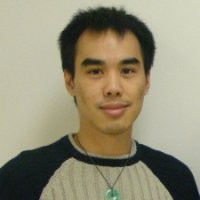
Congratulations to Stanley Tsang who has recently passed his MSc in High Performance Computing with distinction and has been awarded the School of Physics Industry Project Prize for 2013/14.
Stanley was awarded the prize in recognition of his dissertation project that he undertook with Keysight Technologies, the world’s leading electronic measuring company. Stanley’s project “GPU implementation of the Stable Marriage Problem” was judged by the School to have been the best industry project undertaken by this year’s School of Physics Masters students.
The prize, kindly sponsored by Scottish Equity Partners, was announced at last week’s Graduation Reception by Head of School, Professor Arthur Trew.
Unfortunately Stanley was unable to receive the prize in person as he has since returned to Canada to take up employment. We wish him all the best in his future career.
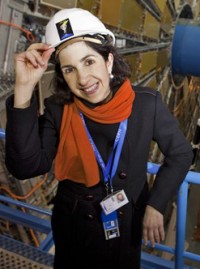
Dr Gianotti, an Honorary Professor associated with the School's Experimental Physics Group, will take up the five-year post on 1 January 2016.
“It is a great honour and responsibility for me to be selected as the next CERN Director-General following 15 outstanding predecessors. CERN is a centre of scientific excellence, and a source of pride and inspiration for physicists from all over the world. CERN is also a cradle for technology and innovation, a fount of knowledge and education, and a shining, concrete example of worldwide scientific cooperation and peace.
"It is the combination of these four assets that renders CERN so unique, a place that makes better scientists and better people. I will fully engage myself to maintain CERN’s excellence in all its attributes, with the help of everybody, including CERN Council, staff and users from all over the world.” Dr Fabiola Gianotti
"On behalf of the whole particle physics group in Edinburgh, as well as the School and the University, I would like to give Fabiola our heartiest congratulations. She is one of the most distinguished and respected physicists of her time, and we know she will do an excellent job as the next Director General of CERN." Prof. Peter Clarke, Particle Physics Experiment group, University of Edinburgh
Dr Gianotti was leader of the ATLAS experiment collaboration from March 2009 to February 2013, covering the period in which the LHC experiments ATLAS and CMS announced the long-awaited discovery of the so-called Higgs boson, recognised by the award of the Nobel Prize to François Englert and Peter Higgs in 2013. She is a member of many international committees, and has received many prestigious awards. She will be the first woman to hold the position of CERN Director-General.
In August 2013, Dr Gianotti was appointed an Honorary Professor in the School, working with Edinburgh staff and PhD students based at CERN and visiting the School for specialist lectures.
Image gallery
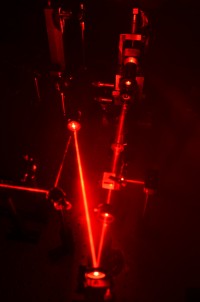
A combination of theory and experiment by researchers in the School's Centre for Science at Extreme Conditions (CSEC) has revealed surprising behaviour in high-pressure dense hydrogen-deterium mixtures. Reported this week as Editor's Choice in the prestigious "Physical Review Letters”, the study shows that the concept of a phonon loses its meaning when isotopes have very different masses.
The great unsolved challenge of high pressure physics is to metallize hydrogen. The giant magnetic fields of Jupiter and Saturn prove the existence of such a material, but it has never been synthesized on Earth or studied at low temperature. The School's Ross Howie and Eugene Gregoryanz, and Alex Goncharov from the Carnegie Institution squeezed tiny amounts of solid hydrogen/deuterium mixtures between diamond anvils, to create some of the highest static pressures ever achieved on Earth. (Their unique experimental set-up in the CSEC laboratories in Edinburgh is shown in the figure.)
However, this means that with the mixtures the Raman signal is three times weaker per mode than in pure isotope and that only by using the state-of-the-art red Raman system provided by the School of Physics was it possible to build the apparatus and conduct these technically-demanding experiments.
Some information about the state of the material was extracted by Raman spectroscopy. Detailed theoretical analysis of the material by Ioan Magdau and Graeme Ackland using EPCC's supercomputers shows that the Raman signal corresponds to a phenomenon known as "Anderson Localization", in which vibrations are unable to propagate through the material. The cause of the localization is the disorder of the hydrogen and deuterium atoms in the structure, which scatters travelling waves.
A further consequence is that all vibrations in the crystal have some Raman scattering effect, compared with the normal case where only a handful of so-called "Gamma-modes" contribute to the observable effect.
But is it metallic? A 2011 report by a group from Mainz claimed in a Nature paper that pure hydrogen was indeed conductive at these pressures. Their evidence was equivocal, but our samples show no sign of metallic behaviour (see papers in Physical Review Letters and Physical Review B), and our calculations suggest there should be a sizable band gap regardless of the isotopic composition. The Germans are debunked and the hunt for metallic hydrogen goes on.
"Phonon localization by mass disorder in dense hydrogen-deuterium binary alloy" Ross T. Howie, Ioan B. Magdău, Alexander F. Goncharov, Graeme J. Ackland, and Eugene Gregoryanz: Phys. Rev. Lett. 113, 175501 (published 21 October 2014).
Image gallery
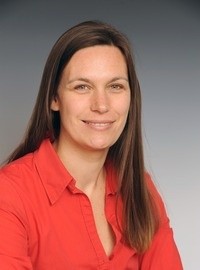
Dr Wood to take up a secondment with the makers of Deep Heat.
Dr Wood will work with Mentholatum in East Kilbride, Scotland, using advanced imaging techniques to look at how the microstructure of the company's major product, Deep Heat, determines its performance. She will also explore new routes to formulation.
"I feel honoured to receive a Royal Society Industrial Fellowship and I am looking forward to working with the company to explore their traditional processes and to developing innovative routes to formulation development," Dr Tiffany Wood
Royal Society Industry Fellowships
The Royal Society has created eight new fellowships aimed at strengthening links between academia and industry. The fellowships are awarded to academic scientists who want to work on a collaborative project with industry and for scientists in industry who want to work on a collaborative project with an academic organisation.
The Royal Society Industry Fellowship scheme provides each scientist's basic salary for the duration of their secondment, which lasts for up to two years full-time or four years part-time.
Edinburgh Complex Fluids Partnership
Dr Tiffany Wood runs the Edinburgh Complex Fluids Partnership (ECFP), drawing on academic expertise within the Institute of Condensed Matter and Complex Systems to help industries solve problems in formulation science and product processing. ECFP has worked with a wide range of industries from food and drink, agrochemicals through to personal care with a focus on dispersions, emulsions, gels and liquid crystal composites. Long-term stability of products, complex behaviour under shear and product innovation are all common themes. ECFP works particularly closely with colleagues in Soft Matter Physics and the Collaborative Optical Spectroscopy, Micromanipulation and Imaging Centre (COSMIC).

